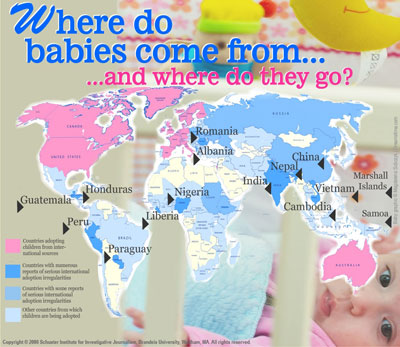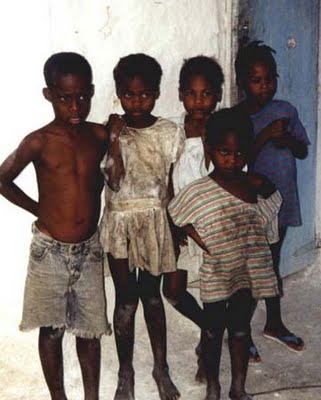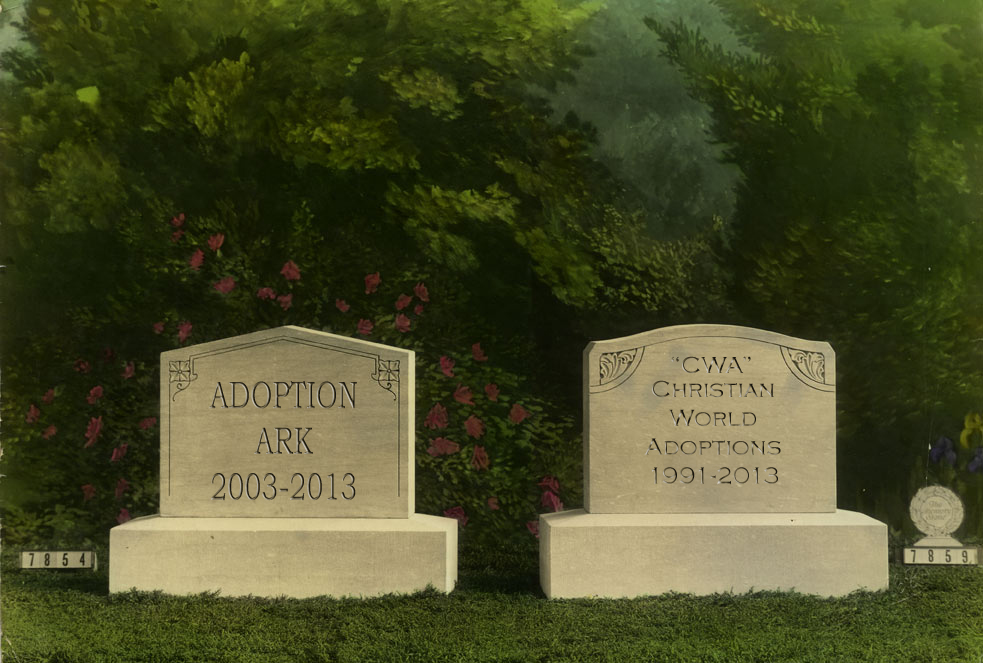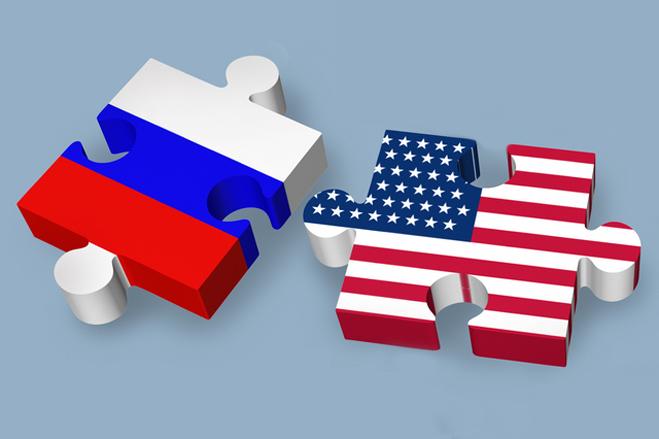Kathleen Ja Sook Bergquist, Ph.D. Assistant Professor, Illinois State University, School of Social Work. M.S.W., Norfolk State University; Ph.D. in Counselor Education, The College of William and Mary
Domestic and international adoption legislation and practice has purported to take into account the “best interest of the child.”
More specifically, the United Nations Convention on the Rights of the Child (CRC) and subsequently the Hague Convention on the Protection of Children and Cooperation in Respect of Intercountry Adoption specifies as a goal, “to establish safeguards to ensure that intercountry adoptions take place in the best interests of the child . . . .”
Given the significant increase in parents who adopt for reasons of infertility or as single parents, and the market demand which has arisen, it would be difficult for anyone to argue that international adoption today exists solely to find homes for parentless children. The purpose of this Paper is to examine the sociopolitical assumptions and implications that are inherent in the placing of children in the diaspora as involuntary immigrants, and whether in fact it is the best interests of the children that are considered. Asian adoption is herein positioned within the history of international adoption, transracial adoption, and shifting parental motivations for adoption.
International adoption in the United States began with the placement of children from Europe following World War II. It grew out of the need to find families for orphans, and was viewed as a humanitarian solution. This precedent paved the way for the Korean orphans beginning in 1954. These children were largely the products of U.S. and other allied nations’ presence in Korea, and President Rhee initiated the overseas adoption program in an effort to deal with the problem of thousands of illegitimate biracial children. The media’s ability to cover the Korean War and carry the plight of the orphans into the homes and hearts of middle America fueled rescue fantasies in a way that was not possible during World War II.
Harry Holt, an Oregon farmer and devout Christian, took on the personal mission to find families for the thousands of parentless children. Holt International continues Harry Holt’s work, placing more children from Korea than any other agency. The social upheaval and poverty of a country torn apart resulted in the continuation of Korean overseas adoption. Remarkably by the mid-1980s,
South Korea experienced rapid economic solvency through industrialization and urbanization, while overseas adoptions also reached a peak with over 6,000 children placed in the United States. China and Russia have since surpassed South Korea as sending countries. In 1991 China constituted 25 percent and Russia 22 percent of all international adoptions in the United States. Since 1998, between 4,000 and 5,000 Chinese children, mostly girls, have been adopted per annum by U.S. families. It is important to note that international adoption programs exist in many other Asian, Latin American, and Eastern European countries, although they are less significant as far as number of children placed. Particular recent media attention has been given to Romania and Cambodia, because of accusations of institutional deprivation and/or corruption.
The compassionate response of American families in opening their homes to Korean War orphans superficially resembles the international adoption of European children following World War II. However, there are several factors which make both experiences qualitatively different.
First, the orphans from World War II were all children from countries, viewed by most Americans to be “equal” but for the immediate circumstances, first-world white European. Interethnic differences aside British, Italian, and German children were considered to be capable of assimilating, and were often adopted by families who shared their ethnic heritage. In contrast, Korea was a third-world country with a long history of occupation and colonization by China, Japan, and the United States. The U.S. presence in Korea was to largely protect its own interests, namely military holdings, and the people of Korea were not in a position of power.
This fact defined the relationship between the two countries, and families who adopted Korean children were seen as extraordinarily benevolent. Prospective parents tended to make their decisions based on religious or moral dictates to save the children from their fate as orphans and to rescue them from the poverty and third-worldness of their country.
The social unrest and change of the Civil Rights Movement and Women’s Movement in the 1960s brought about a new consciousness of brother/sisterhood, global citizenship, and social responsibility. An idealistic fervor and awakening among university students, ethnic communities, and feminist camps demanded that the U.S. face its legacy of racial and gender politics. Families who adopted Korean, and other non-white children during the late 1960s early 1970s often attributed their decision in part to their commitment to promoting social justice. Joe Kroll, executive director of the North American Council of Adoptable Children and a parent of a Korean adopted daughter, in his testimony before the Subcommittee Hearing on Interethnic Adoptions stated,
As transracial adopters in the 70’s, my wife and I (and many others) went blissfully into the process thinking we would save children and integrate society by integrating our family. No one asked our infant daughter what she thought. As white adults we had certain privileges that allowed us to pick and choose from where our children would come.
The National Association of Black Social Workers (NABSW) in 1972 vehemently opposed the transracial adoption of African-American children into white homes arguing for same-race placements and stating that:
“[b]lack children belong physically, psychologically and culturally in [b]lack families in order that they receive the total sense of themselves and develop a sound projection of their future . . . .Black children in white homes are cut off from the healthy development of themselves as [b]lack people . . . . We . . . have committed ourselves to go back to our communities and work to end this particular form of genocide.”
Response to their official statement was immediate, and the placement of African American children into white homes sharply diminished.
Similarly, indigenous children were being placed outside of tribal context into white homes. Prior to 1978 it is estimated that between 25 to 35 percent of Native American children were transracially placed.The Indian Child Welfare Act (1978) , predicated on tribal sovereignty, attempted to decrease the prevalence of transracial adoptions, although met with limited success. Meanwhile, Korean children continued to be placed transracially and in increasing numbers, with a dramatic peak of almost 5,000 between 1975 and 1976.
Motivation to adopt internationally had shifted from child-focused to parent-focused.
The charitable inclinations to provide families for parentless children seemed to transition to a more pseudo-altruistic need to make a social statement about participation in and responsibility to crossing racial boundaries. Families and communities were often singularly integrated by these adoptees. The increasing number of couples in the United States during the 1980s who were delaying having children to begin careers accompanied a rise in infertility and a decrease in the number of available healthy white infants due in part to accessible abortions, rising acceptance of single parenthood, and more effective birth control. International adoption became a matter of finding children for childless couples. Motivation for adoption had shifted from the altruistic, finding a home for a parentless child, to the supply and demand economics of finding children for childless couples.
Considering the desire for couples to adopt healthy infants, and the lack of availability of white children, one might wonder why couples made the leap from domestic to overseas adoption. The practice of transracial placement of African American children into white homes continues and is projected to increase with the passage of the Interethnic Adoption Provisions and the Adoption and Safe Families Act of 1997. Nonetheless, the placement of Korean children hit an all time high in 1986 and may have continued to today if not for the 1988 Olympics in Seoul . Bergquist, Campbell, and Unrau conducted a study of adoptive parents that indicated the primary motivations to adopt from Korea rather than domestically were 1) shorter waiting periods and 2) an interest in international adoption. These findings reflect the pragmatism and parent-centered motivations in adoption, and perhaps suggest a romanticization or exoticization of the country of origin.
Asians have a history of otherness in the United States, characterized as the perpetual foreigner while at the same time held up as the model minority. Hegemonic recreations of Asianness into orientalness commodifies and essentializes Chinese, Japanese, Korean and other Asian realities—and in many cases contrived realities—into consumable entities. Orientalist representations in marketing, fashion, coffee house chai, and Asian fusion cuisine abound.
Where do Korean and other Asian adoptees fit into this context?
I would argue three points.
First, international transracial adoption represents, in part, a misguided attempt to soothe the national conscience and allay the collective guilt of centuries of racism and oppression to people of color. Secondly, the relative success of Asian adoption has been held up as a validation of the model minority myth, positioning adoptees as diversity mascots—especially to the African American and indigenous communities. Finally, international adoption represents a form of neocolonialism. I will address each point below.
The United States has yet to come to terms with its legacy of racism and oppression, although many Americans feel that it is finished business and often wonder, “why can’t we just move on?” The willingness of white Americans to open their homes to Korean and Chinese orphans is often lauded as markers of a color blind multicultural society. The good intentions and genuineness of those parents and families are not being challenged in this analysis, rather this paper attempts to deconstruct international adoption and the assumptions of privilege which facilitate and sustain these crosscultural/crossnational placements. Transracial adoptive parents in general, not just those with Asian children, tend to be publicly acknowledged for their selflessness and courage in taking on the challenge of raising children of color, which seems to be a curious response if the U.S. is truly multicultural and inclusive and if racism has been relegated to vague historical references to slavery and possibly the Japanese internment.
The precarious position which Asians find themselves in the United States as the model or positive minority is at the same time misrepresentative, divisive, paternalistic and a myth. It disregards the socioeconomic diversity between and within ethnic groups and the role that the United States immigration policies have played in determining who are allowed to enter. It also deepens racial divide and feeds interethnic competition: “Asian Americans also find themselves pitted against and resented by other racial minorities and even whites. If Asian Americans can make it on their own, pundits are asking, why can’t poor blacks and whites on welfare?” Frank Wu purports that Asian Americans’ vindication of the American Dream serves as a reminder of the failure of race relations in the U.S., stating that “the myth is abused both to deny that Asian Americans experience racial discrimination and to turn Asian Americans into a racial threat.”
The model minority myth is predicated on paternalistic and condescending assumptions that Asian Americans are remarkable, given that they are a racial minority. Korean and other Asian adoptees are positioned as pawns or trump cards in the perpetuation of this myth.
Early adoption research documented the successful adaptation of minority children into their white middle class families and more recent studies have indicated that these children do well in school, attach to their adoptive families, and have relatively few psychosocial or behavioral problems in comparison to their white peers. Researchers have consistently been conservative in their interpretation of these results, suggesting that the studies may not address relevant measures of success, i.e. racial identity development, and are often limited to selfselection in sampling, parental reports, and lack of consideration for the long term impact across the life span. Crossracial comparisons have also been made between adoptions of African American and other children, finding for the most part that Asian American adoptees are better adjusted and encounter less problems behaviorally and socially—serving to bolster the model minority myth and creating divisive tension. What deserves more attention are the mitigating or contributing factors, such as racial stratification and the more virulent racism experienced by African Americans.
Critiques of transracial adoption research, which includes the placement of Asian children into Caucasian homes, have identified fundamental methodological flaws in earlier research and have suggested strategies for promoting greater cultural relevance in adoption practice. Park and Green argue that transracial adoption research has been Eurocentric, implicitly and explicitly utilizing measures of success and well-being as defined from a majority perspective. Moreover, Goddard points out that such measures are predicated on the conceptualization of self-esteem as individualistic and therefore incongruent with a collective identity and the reality that racialized groups in the United States are positioned as members of an ascribed identity.
Adoption usually involves an exchange between a resource rich and resource limited community or country. Economic necessity is one of the dominant factors in relinquishment, whether it be by a birth parent or a country whose social services infrastructure cannot support the number of children in care, at least initially. The neocolonialism inherent in that exchange is striking. The acquiring of a country’s or people’s resources as a necessary function of colonialism is arguably the case in international adoption, with children being a national resource. Notably, Korean children who are internationally adopted tend to be the easiest to place—being for the most part healthy infants—while the less adaptive children are left to linger in orphanages.
As one adoptee argues:
International adoption isn’t the answer to improving the overall plight of children in developing countries. Even the strongest supporters admit the movement of adoptees across international borders represents only a tiny fraction of the neglected, abused and abandoned children in these countries. And supporters of international adoption are quiet about the children who are left behind.”
Hübinette personifies the United States and European countries as refusing to give space to “anything else but rescue fantasies, colonial desires and orientalist performances.” Leslie Doty Hollingsworth presented international adoption within Rawl’s egalitarian context of a distributive method of social justice as exploiting “unjust social structures in the sending countries.” She argues that this practice allows more wealthy Westerners to benefit from poverty in birth countries; sustains social sanctions against children who are marginalized; exploits the feminization of discrimination and oppression; places children at risk for trafficking and abduction, and interferes with children’s rights to national, cultural, ethnic; and family of origin knowledge and access. The practice of international adoption at best does not address precipitating social conditions, providing instead a short term and arguably minimal impact on the problem of homelessness and poverty for children. At worst, it allows countries to abdicate responsibility for enacting sociopolitical change to secure the well-being of all children, thereby positioning receiving countries as complicit in the problem.
This paper represents an earnest effort to begin a critical consideration of the hegemonic assumptions that are inherent in the international transracial adoption of Asian children from Korea and China. The deconstruction of this phenomenon necessitates an examination of the narratives first-world nations have developed regarding underdeveloped or industrializing countries, the shift from a child-centered to parent-centered focus in adoption, and the placing of these unwitting children in the middle of a racial discourse as diversity mascots or model minorities. It is therefore argued that current international adoption practice places the interest of the receiving countries over the interest of the children. If international adoption is in fact to be considered a last resort option, as delineated in the Hague Convention, only after attempts at family preservation and in-country placement, then accompanying criteria must be set to ensure that the first two options are fully exhausted. Receiving countries, if truly engaged in promoting the best interests of children, have the responsibility to support adoptions within sending countries above the interests of a demand-driven Western market and to actively promote the social and economic development of developing countries so that children may remain within their native states.
PDF here: INTERNATIONAL ASIAN ADOPTION: IN THE BEST INTEREST OF THE CHILD? Kathleen Ja Sook Bergquist, Ph.D.





